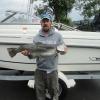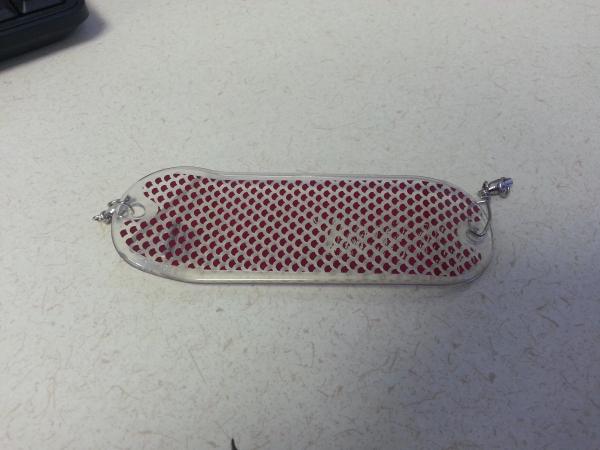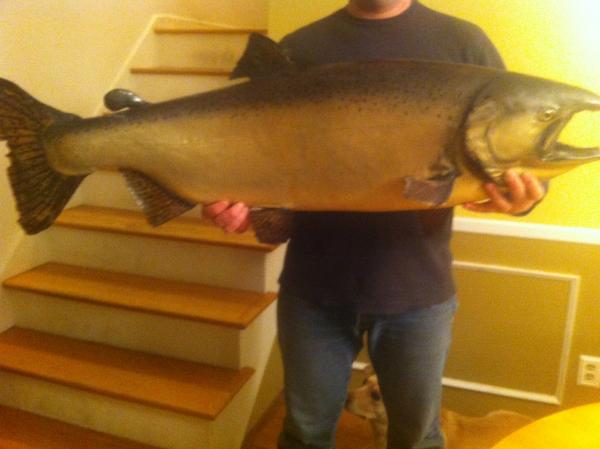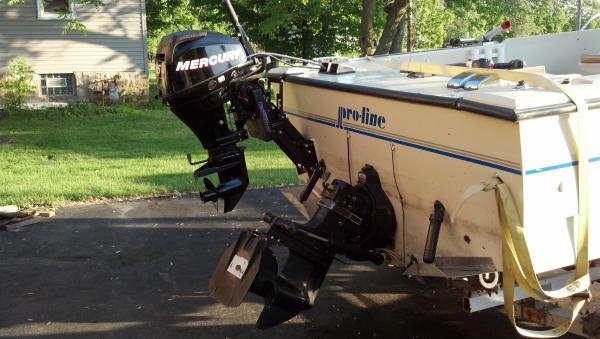-
Posts
13,806 -
Joined
-
Last visited
Content Type
Profiles
Forums
Events
Gallery
Store
Everything posted by Sk8man
-
I was totally JOKING.....I'm just as crazy....and....my son and I both went through this year (at the the same time too on Honeoye) and got to test out my Arctic Armor suit in 4 ft. of water so my comment wasn't exactly unfounded either
-
Cool thanks for reminding us.....hope I can make it as it does give a "glimmer" of what is to come in the stream and lake although that warm spell a few weeks ago may have influenced things a bit ...
-

Newbie looking for setup help
Sk8man replied to rbiz88's topic in Questions About Trout & Salmon Trolling?
There are volumes of info written previously here that you can review here on the site to answer almost any question you might have and all it takes is sometime searching,reviewing things and sorting it out. Your question about the "right" rod and reel depends on a bunch of things like what do you intend to run on them for line and lures, running straight off the boards or using dipseys etc. I'm sure most of your concerns have already been answered somewhere here. -

Setup/ Leadcore questions
Sk8man replied to howboutthosemets's topic in Questions About Trout & Salmon Trolling?
My advice would be "Take it slow" (many if not most of the guys here have been doing this stuff for years and it becomes "second nature" and most have a lot experience with their particular boat aside from the equipment)). With that said Dave's advice about taking some time to survey your boat setup is good advice.... and actually sit in it and place your rods and holders where they will work and the downriggers and make sure things don't interfere with each other ( e.g. check clearances). Eyeballing other boat setups from pics or in real time certainly won't hurt either ...we all learn from it. The take one thing at a time ....downriggers first as they will be a mainstay and will pretty much be staying "put". Physically place all your equipment in the holders etc. in a "mockup" on your property somewhere before you get on the water...that's the time to iron things out not on the water and look for potential conflicts and problems with placements. Once you have your boat in order take a close look at what you want to do equipment wise. Think about the species you want to target, considerations relating to the season (e.g trolling in the shallows in the Spring, or chasing steelies and salmon out deep... they are each very different considerations....in other words you will probably not be running your wire rigs or 10 colors of leadcore or magnum dipseys in 6 ft. of water for browns...equipment changes occur with the change of seasons so think it through one season at a time. One of the other things is that I don't see a trolling motor mentioned so will your IO troll down enough for you to use it for everything? Are your current rod holders strong enough to support your wire rigs and leadcore or dipseys? The list could go on and on but my point is you should "make sure your horse is in front of the cart"... get the basics accomplished and the rest will follow more smoothly. That should also help with the identification of other things you may need to get make your system work effectively (both boat-wise and equipment wise). I know full well the excitement of getting a new or different boat and right now I have withdrawal symptoms from trolling for trout and salmon and am itching to get back out there....but it also needs to be done safely as well. You need to be sure of your boat and how it handles out there before making any hard fast conclusions about how your fishing equipment will function. There is a wealth of information on this site about the ins and outs of the fishing equipment, and it can save you a lot of time (YEARS) by taking some time and looking at it closely as many of your questions will be answered by it. Best of luck with things ...I look forward to seeing you out there. -
I think it is then too.
-
Hope the DEC doesn't check IQ's on those guys
-
It does look cool but I'd carefully check out things beforehand e.g. 13.6 volts and 400 amp burst etc. and how it would operate in your application (marine use) or if would void a warranty if you have one on the motor. I wonder what the difference is in the special charger they offer relative to the amperage your alternator would be putting into the battery. Pretty slick if it would work! The beers may help ease any anxiety :>)
-
By the way I agree with Rolmops you have made VERY good use of the space you have there......very neat and orderly ...lots of room left for tangled lines and that kind of stuff too
-
You might be able to get away with placing the small gas tank ON the shelf (bracketed and secured by something like a metal not plastic battery tie down) that could free up the corner space on the floor I had previously mentioned the marine battery starter thing that has multiple uses and which can start up MANY low batteries as well. You could even store iit up in front or under a seat or something. That way you would have emergency start up capability but not be committed to a specific space. I have two of them that I keep for home use as well and I've helped countless people out (cars and boats) with the things. Some even have USB slots to charge your cell phone Here is what I'm talking about (mine is different but same concept) http://www.cabelas.com/catalog/product.jsp?productId=747143&destination=%2Fcatalog%2Fproduct.jsp%3FproductId%3D1191397%26type%3Dproduct%26Ntk%3DAllProducts%26searchPath%3D%252Fcatalog%252Fsearch.cmd%253Fform_state%253DsearchForm%2526N%253D0%2526fsch%253Dtrue%2526Ntk%253DAllProducts%2526Ntt%253Dmarine%252Bstarter%252Bbatytery%2526x%253D0%2526y%253D0%2526WTz_l%253DHeader%25253BSearch-All%252BProducts%26Ntt%3Dmarine%2Bstarter%2Bbatytery%26WTz_l%3DHeader%253BSearch-All%2BProducts&WTz_l=YMAL%3BIK-524079
-
Maybe it works after you drop some of your coffee on it around nineish
-
One of the things to consider battery-wise is that marine batteries are specifically designed to withstand considerably more VIBRATION than conventional car batteries I don't have any experience (or knowledge) regarding motorcycle batteries but where you place another type than a marine one may be a consideration.
-
I've had 10 of the original 47H's and 2 Great Lakes LC's since the mid 1980's and I have never had a single problem with them (I hope I'm not jinxing myself here :>) I just recently bought SG47LC3b's for wire rigs and I hope these new ones hold up as well as the old models. They took the 1000 ft. of 30 lb wire and mono backing real well The drag is supposed to be the one they use in their heavy duty salt water reels according to the tech rep so I'm holding off on installing the carbon fiber drag washers until see how these work out.
-
FSNmachine - :smile: :smile:
-
The smaller spoons part of it is most likely the more productive part other than perhaps in the Spring when they don't seem as line shy or fussy. I don't know personally of their use on Seneca or Canandaigua but I'm sure there are folks out there that have tried about just everything new or different to get those tricky @#$%@#'s to hit
-
I think this may be more difficult than might appear at first glance in terms of catching them in numbers anyway.....
-
Hopefully we won't be returning to the TWO RODS PER PERSON which was in effect prior to this temporary experimental period where three rods are allowed (which is set to expire in December 2013).
-
When I bought my boat brand new I was told that because my 9.9 and 135 Optimax had different alternator amperages that if they were hooked up to the same battery they could shorten the life of the battery and may create (otherwise unspecified) problems so I've always had two batteries - one a heavy duty starting battery the other a heavy duty combination deep cycle and starting battery. The starting battery is hooked up to the 135 (and depth finder etc.) while the other battery is hooked up to the 9.9 and my electric downriggers and electric trolling motor. I was told by a number of marina mechanics that my 135 (and engines like it) needed at least half charge in the battery at all times to turn over the engine because of the high amperage draw they have. I have NEVER had a problem with this set up (other than normal battery replacement once since 2002). Don's comment above about the charging capability of the small motors alternator is a good one too. Unless they are run at HIGHER speeds they are not charging with anywhere near the max amperage you might assume. My advice would be to have TWO batteries and get the best ones you can afford. They are at the heart of everyone's system and its not an exaggeration (on Lake O) to say that your very life could depend on it (dead batteries almost always happen at the worst times). Kuba I just happened to think of an additional possibility and that is a PORTABLE MARINE starting unit that has multiple uses and you can take it from boat to boat as well. They are quite powerful and are rechargeable in conventional electrical outlets. Places like Cabelas have them for about the cost of a good battery (about $100)
-
I just took a look at the pricing.....no wonder they held off on publishing it Actually, the whole electronics game is getting pretty funny, and to take it to the extreme the fishing game is getting even funnier when it comes to the "new next best thing". If you are a charter captain dealing with the extremely short season here in New York State (and the East Coast for that matter) the latest "gizmos" may make a difference in attracting your customer base, but for the rest of us "wannabes" at the periphery the purchase of many of these "new technological advancements" is far from the "need to have" category in the fish catching realm. We talk ourselves (and our wives sometimes) into the need for much of this "stuff" and treat it as absolute necessity because marketing people tell us we need it to catch fish. The same is true for lure paint jobs and in my previous world - the newest computer and camera equipment which from the late 80's I spent enough to buy several brand new boats and it now is totally obsolete and basically useless. At this point in my life I am beginning to resent being part of the "herd" mentality and "biting" on these new "lures". A return to the old basics of actually fishing and feeling a sense of accomplishment when you figure things out yourself rather than relying on the latest "gizmo" to provide you with data that in many cases can be close to useless because you've forgotten the basics of the sport....just another way to blow your money in my view....and yes it has become a big part of the "game" these days. I'm not badmouthing this product in any way but trying to make a point .....maybe we are getting a bit far afield from sport fishing itself and sucked into the marketing hype of the electronics world.
-
-
In the Spring look for the warmest water you can find (off power plants or sometimes stream mouths) for browns (look wherever you see pods of bait all season long). Browns can tolerate less dissolved oxygen content and are often at home in murky water and higher temps than rainbows.They are often found inside mud lines in the shallows of lakes in the Spring. They love areas where there is shallow water nearby drop-offs and they often suspend off these areas as the summer progresses but also can be bottom oriented in the Spring like lake trout. Rainbows can usually be found near stream mouths in the Spring but in summer they are found largely distributed throughout the lakes in deeper water above the thermocline or sometimes within it but seldom below it. Browns are less predictable in summer but almost always located near bait. In late summer to Fall browns are found near stream mouths while rainbows are often found out deeper all over the lake. I know I didn't give specific temps but those aren't as reliable as knowing their general habits. This is at leas t what I have found in my 50 plus years of trolling for trout and salmon. Others may have additional things to add or different experiences. Mine is based on combined Finger Lakes (mostly) and Lake Ontario to a lesser degree. In terms of speed it is dependent on very many factors (time of year, wind direction and speed, currents, type of lures or rigs used etc.) but n general browns like slower speeds and a lot of distance in the lines (and light lines where possible) as the season progresses and often smaller spoons or stick baits. Rainbows like faster speeds many are caught on fast turns going diagonally or across currents...i..e. they like a lot of action.
-

When can I use a snap swivel and when do I need to tie?
Sk8man replied to Sneaky Duck's topic in Tackle and Techniques
For the type of stuff you said you are currently doing a size 3 will cover most situations -
-

When can I use a snap swivel and when do I need to tie?
Sk8man replied to Sneaky Duck's topic in Tackle and Techniques
This is something that books could be written about but after 60 years of fishing for just about everything in freshwater and quite a bit in salt water I would say that for most lures especially spoons (heavy ones and flutter spoons large and small) you will want to use a swivel to help keep the line from twisting and to allow the lure to have uninhibited action. The key is using the smallest high quality ball bearing swivel you can get away with for a given lure that is still strong enough for the targeted species. Use single ring (soldered/welded ring) rather than split ring type to prevent line cut offs with large fish. For items like stickbaits (e.g. Rapalas, Smithwicks, and the like) a swivel like that just mentioned can be used but many folks PREFER to either tie them directly to the nose ring of the stickbait (often using a looped knot) to preserve the original intended action. If trolling (other than drifting or slow trolling) is desired you may want to opt for a swivel as fast speeds can generate line twist. Another avenue is the use of Fast snaps or Kwik clips for stickbaits which are little metal hook like things which ties directly to the line that allow you to change lures but they don't have a swivel function. I think that is basic "swivel 101" others may have additional info. Good luck with the fishing! -
Sweet! ...but on the downside...I think I'm glowing from looking into the open box




